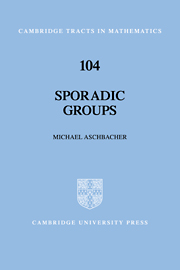Book contents
- Frontmatter
- Contents
- Preface
- PART I
- PART II
- 6 The Mathieu Groups, Their Steiner Systems, and the Golay Code
- 7 The Geometry and Structure of M24
- 8 The Conway Groups and the Leech Lattice
- 9 Subgroups of ·0
- 10 The Griess Algebra and the Monster
- 11 Subgroups of Groups of Monster Type
- part III
- Symbols
- Bibliography
- Index
9 - Subgroups of ·0
Published online by Cambridge University Press: 04 August 2010
- Frontmatter
- Contents
- Preface
- PART I
- PART II
- 6 The Mathieu Groups, Their Steiner Systems, and the Golay Code
- 7 The Geometry and Structure of M24
- 8 The Conway Groups and the Leech Lattice
- 9 Subgroups of ·0
- 10 The Griess Algebra and the Monster
- 11 Subgroups of Groups of Monster Type
- part III
- Symbols
- Bibliography
- Index
Summary
In this chapter we use the machinery developed in Chapter 8 to establish the existence of various subgroups of . 0 and to establish various properties of these subgroups.
For example, in Section 23 we defined the stabilizer of a nonsingular vector ν˜ of λ˜ to be the Conway group C03. In Section 24 we prove that C03 is 2-transitive on the 276 lines of Λ˜ through ν˜ generated by points in Λ˜2, with the stabilizer in C03 of such a line isomorphic to Z2 /μc. Further we prove Mc is a primitive rank 3 group on the remaining 275 lines. Similarly we show HS is a primitive rank 3 group of degree 100 with point stabilizer M22. These representations allow us to prove that C03, μc, and HS are simple.
In Section 25 we prove that the groups Co1 and C02 have large extraspecial 2-subgroups. Similarly we find subgroups α of G = Co1 of order 3,5, such that CG(α)/α has a large extraspecial 2-subgroup; CG(α)/α is Suz or J2, in the respective case. Our theory of large extraspecial subgroups developed in Section 9 then allows us to prove that Co1, Co2, Suz, and J2 are simple.
Finally in Section 26 we establish various facts about the local structure of Co1 which will be used later to construct various sporadic subgroups of the Monster. Chapters 16 and 17 contain much more information about Co1, Suz, and J2.
- Type
- Chapter
- Information
- Sporadic Groups , pp. 124 - 141Publisher: Cambridge University PressPrint publication year: 1994

